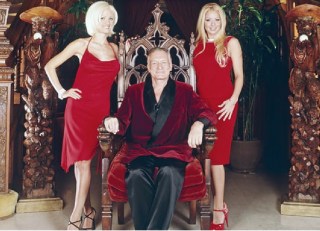
When I was thirteen, I developed a habit of stealing. Not money. Not jewelry. Not even toys. No, I fell into the habit of lifting “Playboys” from my neighborhood drug store. They were kept on the top shelf of the smallish-Reese Pharmacy, far out of reach for my 5’4” frame at the time.
Thus, I had to try really, really hard to stand on my toes to get one, when the pharmacist wasn’t looking. Once I got my prize, I would hide it in a copy of “The Philadelphia Inquirer,” usually the sports section and then nervously approach the counter and plunk down my $.50.
Then I ran. Ran as fast as my short legs would take me. I ran past my dad, lying on a patio couch watching the Phillies on his portable black and white TV. Ran inside, past my brother’s room.
I only stopped when I finally got to my room and closed the door.
As I sat on my bed, I would tear that Inquirer open like a grown man would look to the centerfold.
That was my experience with this mysterious “Hef” and “Playboy.” Until I got caught, but that’s a story for another day.
“Hef,” as he was affectionately called, died last night surrounded by family at the age of 91.
 Hugh Hefner was born on April 9, 1926 at Michael Reese Hospital to Grace and Glenn Hefner. She was a teacher and he was an accountant. The family lived in Chicago on the Northwest side where Hefner and his brother attended Sayre Elementary School. When he was eight, Hef got into publishing by starting a newspaper called, “The Pepper.” There were no nudes at the time. At least that we know of.
Hugh Hefner was born on April 9, 1926 at Michael Reese Hospital to Grace and Glenn Hefner. She was a teacher and he was an accountant. The family lived in Chicago on the Northwest side where Hefner and his brother attended Sayre Elementary School. When he was eight, Hef got into publishing by starting a newspaper called, “The Pepper.” There were no nudes at the time. At least that we know of.
He began the path to his empire in Chicago by taking a job as a copywriter (see how many of us amounted to something?) for “Esquire” magazine. When the publication moved to New York, Hefner decided to stay behind and launch his own magazine.
At the same time, he shared a small apartment in Hyde Park with wife, Mildred Williams, and baby daughter, Christie.
The magazine Hef set out to launch was “Chicago City Magazine. He reportedly took a loan of $3,000 from friends and $600 from the bank in 1953. He decided to switch gears, when he purchased a naked photo of Marilyn Monroe for $200. And on Hefner’s kitchen table, “Playboy,” which he reportedly wanted to call “Stag Magazine” was born. The magazine was to be devoted to subjects that Hefner was interested in — “wine, women and song.”
According to an article in The Chicago Tribune, there was no issue date put on the cover as Hefner was not sure there would be a second one.
The first issue came out in December 1953. Forty-eight pages with a centerfold featuring Monroe. The first run was 70,000 copies. Nearly all sold in two weeks.
The magazine quickly reached a circulation of 1 million eventually reaching 8 million. During the early 60’s and 70’s, arguably the magazines heyday, many imitators came along, including “Penthouse.”
During its heyday, and after divorcing Mildred, one could say Hef’s life became somewhat of a centerfold. Hefner was featured almost monthly in some major publication. When he appeared on the cover of “Time” Magazine, the publication said, “He took the old-fashioned, shame-thumbed girlie magazines, stripped off the plain wrapper, added gloss, class and culture.”
When Playboy Enterprises went public in 1971, the publication had a subscription base of 7 million copies a month, there were 23 Playboy clubs, resorts, hotels and casinos, along with ventures in book publishing, merchandising, modeling, records, TV, movies and a limousine company. The corporation employed 5,000 people, including 1,000 waitresses, dressed in skimpy black silk costumes and known as “Bunnies.”
“Hef” eventually traded his Chicago mansion for the warmer, west coast. In 1975, he donated the mansion to The School of the Art Institute, but still opted to keep the headquarters in the former Palmolive Building on Lake Shore Drive.
The 1980’s began to see the slip of the empire as growing conservatism, the brutal death of playmate Dorothy Stratton came into play. Circulation dropped and the corporation lost its gambling license. Daughter, Christie Hefner, took over running the company in 1982. Finally, in 1985, Hugh Hefner, suffered a mild stroke prompting “Newsweek” to proclaim, “The Party’s Over.”
While most revered “Hef,” there are those who saw him as a clear-cut misogynist. Surita Mansukhani, who is Director of Business Development and Promotions for Hootenanny and What The Hale Music, started her career as a Playboy bunny at the Lake Geneva Club. She offered her take on the pioneer.
“When I was really young I met Hef and Chrissy while working as a bunny,” she says. “They asked me to test shoot for the magazine and although I never did I did find the experience female empowering.”
Before his death, the world had definitely moved on. “Hef,” seemed out of place with his pajamas and hot blondes. Interestingly, our former boss, Ruth Ratny, lived in the same building at one point according to her friend, Nancy Lasch.
Oh, if Ruth were still around to recount any elevator stories.
Contact Colin Costello at colin@reelchicago.com or follow him on Twitter @colincostello.com.




















